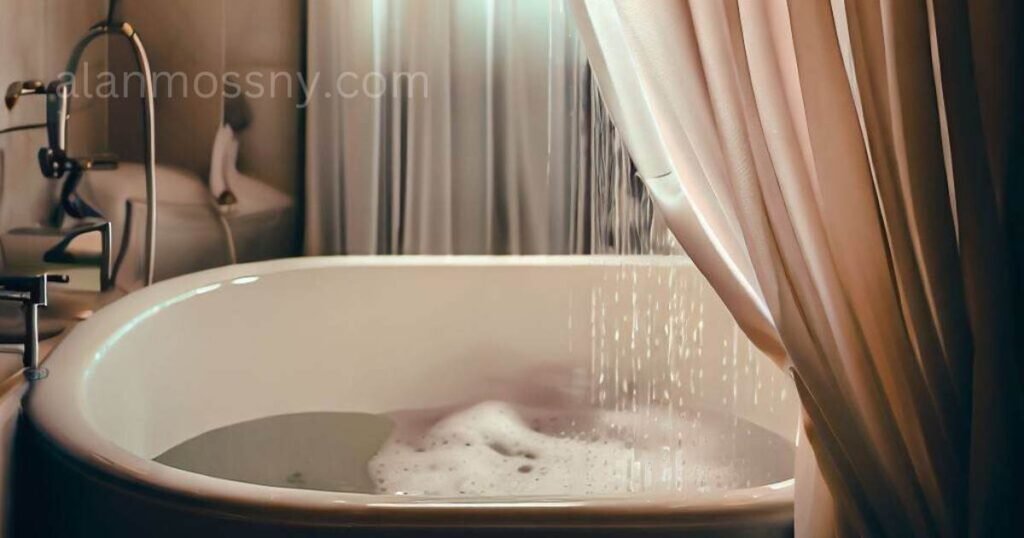Does Shower Curtain Go Inside Or Outside Tub?
To prevent water from splashing onto the floor, the shower curtain should go inside the tub. The placement of a shower curtain is an important things you should know. Let us explore some additional aspects on Does Shower Curtain Go Inside Or Outside Tub?
It is crucial to ensure that water does not escape the bathing area and damage the surrounding surfaces. Therefore, it is recommended to have the shower curtain inside the tub. This positioning allows the curtain to create a barrier, effectively containing the water within the showering area.
By following this guideline, homeowners can maintain a dry bathroom floor and minimize the risk of slips and falls due to water accumulation. Now that we understand the importance of positioning the shower curtain correctly.

Credit: www.alanmosssny.com
Table of Contents
Does Shower Curtain Go Inside Or Outside Tub? Factors We Must Know
Shower curtains are an essential part of any bathroom decor, but deciding whether to place them inside or outside the tub can be confusing. Considering factors such as the dimension of the shower curtain is crucial. It should be long and wide enough to cover the entire tub and prevent water from splashing out.
Additionally, the type of material used for the shower curtain is important too. Opt for materials that are water-resistant and easy to clean. Design and visual appeal also play a role in choosing the right curtain. It should complement the overall aesthetic of the bathroom.
Lastly, moisture control and preventing water leakage should be prioritized. Make sure the curtain is properly sealed and hangs straight to avoid water from seeping through. By considering these factors, you can ensure that your shower curtain serves its purpose effectively, keeping your bathroom dry and stylish.
Pros And Cons Of Placing Shower Curtains Inside The Tub
Placing the shower curtain inside the tub has its advantages. First, it helps to prevent water from splashing outside the tub, keeping the bathroom floor dry. Second, it provides privacy while showering, as the curtain fully encloses the tub area.
Third, it can help to maintain a neat and organized appearance in the bathroom, especially when coordinated with the overall decor. But there are also some disadvantages to think about. For example, when the curtain is inside the tub, it may limit the amount of space available for showering, leading to a slightly cramped experience.
Additionally, if the curtain is not properly secured, it can stick to the skin while showering, causing discomfort. Ultimately, the decision of whether to place the shower curtain inside or outside the tub depends on personal preference and the specific layout of the bathroom.

Pros And Cons Of Placing Shower Curtains Outside The Tub
Placing the shower curtain outside the tub offers several advantages. Firstly, it creates a sense of spaciousness in the bathroom. Additionally, it prevents water from splashing onto the floor, keeping it dry and safe. Moreover, placing the curtain outside the tub makes cleaning and maintenance easier.
You can easily remove the curtain for washing or replacement. There are some disadvantages exist. One drawback is that the curtain may not provide complete privacy, as there may be gaps between the curtain and the tub.
Furthermore, water may still escape from the shower, leading to dampness in the bathroom. Overall, while placing the shower curtain outside the tub has its benefits, it’s important to weigh the pros and cons before making a decision.
Ensuring Proper Water Containment: Extra Measures
Proper water containment is crucial when it comes to shower curtains and tubs. One effective measure is using a weighted bottom to keep the curtain in place. This prevents water from escaping and causing messes outside the tub. Another step you can take is adding a splash guard, which acts as an extra barrier.
Additionally, installing a shower liner provides an added layer of protection against leaks and spills. These extra measures ensure that your shower remains a clean and dry space, free from water damage. So, next time you set up your shower curtain, remember to consider these tips for proper water containment.
Hygiene And Maintenance Considerations
Maintaining proper hygiene and preventing mold and mildew growth in your bathroom requires careful consideration when it comes to shower curtain placement.
This simple practice helps in easy cleaning and drying of the curtain, reducing the chances of mold and mildew formation. Moreover, keeping the shower curtain inside the tub also reduces unnecessary wear and tear on the curtain, extending its lifespan.
By following these hygiene and maintenance considerations, you can ensure a clean and functional shower curtain in your bathroom, promoting a healthy and pleasant bathing experience.
Design And Aesthetic Considerations
Design and aesthetic considerations play a crucial role when it comes to shower curtains. To enhance the bathroom decor, it is important to coordinate with color schemes. Matching the curtains with the existing colors can create a harmonious look. Incorporating patterns and textures adds visual interest to the space.
Bold patterns can make a statement, while subtle textures add depth. By carefully choosing the shower curtain, you can elevate the overall style of your bathroom. Remember to opt for a design that complements the existing theme and reflects your personal taste.
Whether you prefer a minimalist or a vibrant look, the right shower curtain can make a significant difference in the ambiance of your bathroom.

Practical Tips For Placing Shower Curtains
Placing a shower curtain correctly requires attention to detail. First, ensure the curtain is the right size for the space. Measure your shower area accurately to avoid any gaps or overlaps. Next, adjust the height and length of the curtain accordingly.
This will prevent water from splashing outside the tub and keep your bathroom dry. Remember to consider the type of showerhead you have, as different ones may require different measurements. By following these practical tips, you can enjoy a hassle-free shower experience while keeping your bathroom clean and water-free.
Don’t let a simple task like hanging a shower curtain become a source of frustration, take the time to measure and adjust it properly.
Different Types Of Shower Curtains And Their Ideal Placement
Shower curtains play a crucial role in keeping our bathroom floors dry and maintaining privacy. Fabric shower curtains are a popular choice, providing a luxurious feel to the bathroom decor.
These curtains should be placed inside the tub to ensure that water remains within the designated area. Vinyl shower curtains, on the other hand, are more durable and resistant to mildew. They can be placed both inside or outside the tub, depending on personal preference.
Plastic shower curtains are inexpensive and easy to clean. Understanding the different types of shower curtains and their ideal placement is essential for maintaining a clean and functional bathroom environment.
Addressing Common Concerns And Questions
Water escaping from the tub is less likely if the shower curtain is placed outside. The risk of slipping can increase if the curtain is placed inside. Yes, you can use both an inside and outside shower curtain to provide extra protection against water leakage.
Safety Considerations For Shower Curtain Placement
Shower curtain placement plays a crucial role in ensuring safety in the bathroom. When positioning the shower curtain, it is important to consider potential trip hazards and accommodate accessibility needs. The shower curtain inside the tub prevents water from splashing onto the floor.
Additionally, having the shower curtain inside the tub creates a barrier that helps keep the rest of the bathroom dry.
By following these safety considerations, you can maintain a safe and comfortable showering experience while keeping your bathroom free from water damage.

Ensuring Longevity And Durability Of Shower Curtains
To ensure the longevity and durability of shower curtains, proper care and maintenance are essential. Regularly inspecting the curtain for any signs of wear and tear is crucial. If you notice that the curtain is starting to look worn-out or has holes, it is best to replace it promptly.
Additionally, it is important to clean the shower curtain regularly to prevent mold and mildew buildup. You can either hand wash the curtain or put it in the washing machine, following the manufacturer’s instructions. Properly drying the curtain after cleaning is also important to prevent any moisture-related issues.
By following these simple steps, you can extend the life of your shower curtain and maintain a clean and fresh bathroom environment.
Frequently Asked Questions On Does Shower Curtain Go Inside Or Outside Tub
Can A Shower Curtain Go Inside The Tub?
Yes, a shower curtain can go inside the tub. This helps prevent water from splashing onto the bathroom floor.
Should The Shower Curtain Be Inside Or Outside The Tub?
The shower curtain should be inside the tub. This ensures that water stays inside the tub while showering.
What Is The Purpose Of Having A Shower Curtain Inside The Tub?
The purpose of having a shower curtain inside the tub is to keep water contained within the bathing area and prevent it from splashing onto the floor.
Will A Shower Curtain Outside The Tub Prevent Water From Splashing?
No, a shower curtain outside the tub won’t effectively prevent water from splashing. It is recommended to have it inside the tub for better containment.
Can I Have A Shower Curtain Both Inside And Outside The Tub?
Yes, you can have a shower curtain both inside and outside the tub. However, it is not necessary and may hinder movement within the bathroom.
What Are The Benefits Of Having A Shower Curtain Inside The Tub?
Having a shower curtain inside the tub helps maintain bathroom cleanliness, prevents water damage, and makes cleaning easier by containing water within the bathing area.
Is It Possible To Use A Shower Door Instead Of A Curtain?
Yes, using a shower door instead of a curtain is a viable alternative. It offers a more permanent and watertight solution, but can be more expensive to install.
Conclusion
Considering the placement of a shower curtain is essential for maintaining a clean and functional bathroom. Based on the information provided, the shower curtain should go inside the tub, rather than outside. This prevents water from splashing onto the floor, ensuring a dry bathroom and reducing the risk of slips and falls.
Keeping the curtain inside the tub also helps to protect your bathroom walls and floors from water damage and mold growth. In addition, it maintains the privacy of your showering experience. Remember to regularly clean and maintain your shower curtain to prevent the buildup of soap scum and mildew. Our social media.

